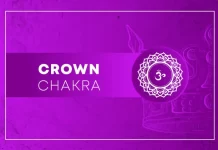Anjali Mudra is a hand motion that encourages the activation, balancing, and alignment of our body’s energy flows. It supports maintaining inner equilibrium, awareness, and connection to your Higher Self as well as your intuition.
I’ll introduce you to this effective mudra, go over how to do it, and list all the advantages of doing so in this article.
Depending on the recognized mudra, the placement of the hands and palms in a particular way, or mudra, controls the flow of energy and directs it to a particular location of the body. We can open up the meridians and channel energy throughout the body by linking our fingers in specific patterns.
Energy pathways can be closed or cleared using various finger positions. Additionally, we influence the biologically active places on the palms and fingers by using this or that mudra.
Mudras assist us in controlling prana, adjusting the body’s flow of energy, and enhancing our psycho-emotional state. Additionally, with their assistance, we can click on certain acupuncture points to solve physical and emotional issues.
Each hand’s finger represents a different type of energy.
Knowledge and confidence are linked to the index finger. It is connected to our vital energy.
The middle finger is in charge of developing patience and emotional self-control. The heart chakra and the Anahata chakra are both connected to this finger.
Health and vigor reside on the ring finger. The nerve and respiratory systems are linked to this finger.
The little finger is linked to the personality trait of creativity and the capacity for aesthetic appreciation. The pelvic organs are controlled by this finger.
The thumb is in charge of our will, ego, and logic. This finger also represents alertness, knowledge, and wisdom.
Each finger also has connections to other body components and internal organs. One “projection” of the head is the upper phalanx of the thumb. The right and left hands are represented by the little finger and index finger, while the right and left feet are represented by the ring and middle fingers.
When you use your hands to make mudras, you unquestionably stimulate the body’s systems and organs that are directly associated with the energy pathways that go through the palms and fingers.

5 fingers and 5 elements
Did you know that each of the five elements is represented by one of your fingers?
The fire element is represented by the thumb.
The energy of the element of Air is associated with the index finger.
The ether is controlled by the middle finger.
We are connected to the energy of the Earth through our ring finger.
Water is represented by the tiny finger.
Thus, you disperse energy in your body by using mudras. When you practice Hatha yoga, you control its flow by opening and closing energy pathways. The sole distinction is that in Hatha yoga, different body poses are used to produce this effect, whereas yoga mudras use the fingers to do the same thing.
All of the body’s elements are awakened when all the fingers and their tips are touching in the Anja Mudra. Regular application of this mudra maintains the equilibrium of all the body’s elements, as well as all the tissues and parts that make them up.
Justifying the term Anjali
“Anjali” is a Sanskrit word that denotes a divine offering or greeting, while “mudra” refers to a hand motion. The salutation seal is called Anjali Мudra. In India, it is also referred to as Namaskar mudra or Namaste. Using praying hands, it is created.
There are many nuances and ways to interpret the word divinity. In yoga, Patanjali—the founder of yoga—is also linked to Anjali’s auspiciousness. Nevertheless, there is a common understanding that transcends all civilizations and religious traditions: divinity is the union of all cosmic energies, which is the origin of all creation.
So when you do Anjali Мudra, you are offering to the divinity, the only thing you could possibly offer is a part of that divinity that resides within you. The Anjali Mudra helps you to unite the conflicting forces within your body and activate the small portion of divinity residing in you.
By means of divine offering, this mudra represents the unification of our soul with the supreme soul. Further, this union neutralizes the negative and positive energies within us.
The significance of Anjali Mudra
The most expressive parts of your body are your hands, or more precisely, your palms. It can convey your mental, emotional, and physical well-being. Consider all the activities we do with our hands, including building, fighting, producing art, farming, caring for others, and killing.
You have the capacity to give form to every thought, feeling, and emotion you have through your hands. According to science, your hands and fingertips are made up of a complex network of nerve endings that allow you to express yourself in a variety of ways with your hands.
Union of Opposites

After learning the value of your hands, let’s learn the value of clasping them together in the Anjali Mudra or Namaste. The left and right sides of our bodies stand for the dual nature of all of our feelings, thoughts, and perceptions. For instance, our preferences, desires, aversions, rationality, and intuition, among other things.
A condition of equilibrium is created when the energies flowing on our left side (In Ida Nadi) and right side (In Pingala Nadi) combine. Our physical and mental health depend on this equilibrium. Consequently, you can be confident that some type of left-right balance has been disrupted whenever you suffer a physical or mental illness.
Anjali mudra entails bringing both of your palms together at the center of your chest. This hand motion is known as a “centering stance” because it unites the nerve endings on both of your hands, joining the left and right hemispheres of your brain.
It is utilized to help the practitioner achieve dhyana, or the meditative state, by relieving mental stress and anxiety when we make the Anjali mudra with our hands in the middle of our heart chakra.
How do we use Anjali Mudra in Yoga Practice?
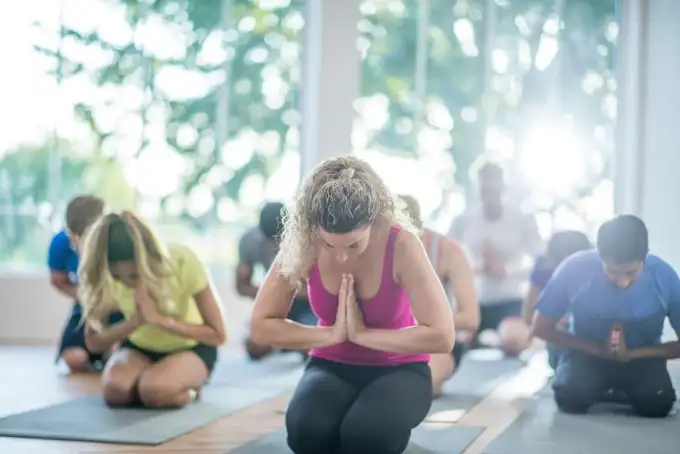
Anjali Mudra is an important part of yogic practices, including the asana, which represents the most prominent physical aspect of all yogic practices. During the practice of asanas, the Anjali mudra can be performed in three instances: before going into a yoga pose, during the hold, or after the pose.
Before going into a pose: When the Anjali mudra is performed before going into a yoga pose, it is used as a preparatory step. It helps calm your muscles and nerves and creates a harmony of energies. This harmony will help you approach the posture with greater awareness and efficiency.
When performing yoga poses: When the Anjali mudra is performed while you’re in a yoga pose, it’s done with the intention of magnifying a particular benefit. The Anjali mudra can be performed with the Goddess pose, thunderbolt pose, mountain pose in a sun salutation, etc. It will optimize the flow of energies to specific parts of your body. This will, in turn, increase the stimulation and efficacy of the yoga pose.
When the Anjali mudra is executed at the conclusion of an asana, the goal is to bring your mind and body back into balance. This factor may be crucial in helping to prevent injuries during your yoga practice. Yoga positions can put a lot of stress on your body and psyche. You’ll frequently experience a disruption in the balance of your energies after engaging in such stances. Harmony will be restored by completing the position with the Salutation seal, which will resolve the problem of interruption.
Anjali Mudra with different hand postures
The positioning of the hands in the posture is just as significant as the timing of the Anjali Mudra. You can perform the Anjali mudra with your hands in a variety of positions, including high above your head, directly in front of your forehead, directly in front of your throat, and in front of your chest.
In addition to establishing left-right balance, each position has advantages for a certain set of mind-body biomechanics.
High above your head: Raising our hand high above the head and joining our hands in Anjali mudra, helps us connect with forces beyond our physical existence.
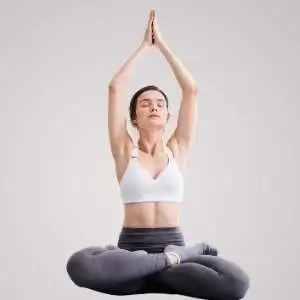
High above your head: Raising our hand high above the head and joining our hands in Anjali mudra, helps us connect with forces beyond our physical existence.
Our body has seven chakras, or energy centers, which we often hear of in yoga. However, there are other chakras above our body, like the soul star chakra, spirit chakra, universal chakra, and such. If you are looking for meditative tools to connect with the core essence of the universe, this form of Anjali is what you are seeking.
 Right above our head: Anjali mudra hands just above the head is called Kailash mudra. The seventh or crown chakra at the top of our head corresponds to spiritual connection. Anjali Mudra’s hands just above the head bridge between the energies within your body and outside. It helps you attain spiritual awakening.
Right above our head: Anjali mudra hands just above the head is called Kailash mudra. The seventh or crown chakra at the top of our head corresponds to spiritual connection. Anjali Mudra’s hands just above the head bridge between the energies within your body and outside. It helps you attain spiritual awakening.
Right in front of your forehead: It’s the location of the third eye chakra that corresponds to your pineal gland. When Anjali mudra is performed with hands keeping on the forehead, it’s known as Namaskar mudra, Pranam mudra, or Prayer mudra. In terms of bodily functions, Namaskar mudra will enhance your awareness and nervous functions. The forehead chakra, or your third eye, is the link between your spiritual and materialistic existence.
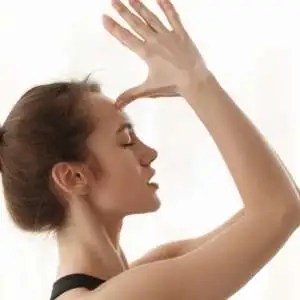 Right in front of your throat: When you perform the Anjali mudra keeping your hands in front of the throat, your throat physiology and the surrounding region will receive health benefits. It will improve your vocal functions and resist infection in the throat region. Our vocal apparatuses are considered the most critical medium of human communications. Thus performing Anjali mudra in front of your throat will also bring harmony to the energies involved in the communication process.
Right in front of your throat: When you perform the Anjali mudra keeping your hands in front of the throat, your throat physiology and the surrounding region will receive health benefits. It will improve your vocal functions and resist infection in the throat region. Our vocal apparatuses are considered the most critical medium of human communications. Thus performing Anjali mudra in front of your throat will also bring harmony to the energies involved in the communication process.
Right in front of your heart: Your heart chakra or the heart region is elemental to benefit your blood flow and oxygen management. Postures that benefit your respiratory and cardiovascular functions often accompany the Anjali mudra in front of the chest
Can you feel the difference in energy in these variations?
Your unification of energies aligns with your pineal glands as you clasp your hands together in front of your forehead. Your senses of perception should become more acute as a result, making you feel more alert and concentrated. The chest, on the other hand, improves your breathing and blood flow and makes you feel more at ease.
You will feel new energies, the energy that is external to your body, as you raise your hands higher and farther up. Your senses of perception will extend to make contact with the environment. You will be able to accomplish what is referred to as a state of absorption in yogic terminology.
How do we use Anjali Mudra in daily life?
The Anjali mudra is a gesture that is ingrained in Indian cultural body language in addition to being employed in yoga activities. The Anjali Mudra is used for a variety of tasks during the course of a typical day.
1. To Worship
The Anjali mudra is mostly used as a devotional gesture in everyday life. We express our appreciation to God through the Anjali Mudra. This action symbolizes our entire surrender to the forces of divinity.
Anjali mudra is used as a symbol of reverence and adoration for a higher power. In other words, we utilize this gesture to express our gratitude and delight and Bhakti for whatever we have.
This gesture can be used to adore any deity, person, or object that you hold in high regard. It could be a sort of meditation in which you merely give up and give thanks to the origin of all creation.
2. To greet someone
Anjali mudra is a salutation that is used to greet someone in India whom you respect. Namaste is a hand motion used to greet someone.
The phrase “Namah-st-e” is a mixture of two words. Namah means to bow, and he is the plural of you. It’s code for “I bow to you.”
Namaste is a greeting that is taught to us in India as a sign of politeness. It is almost akin to saying hello but with respect added. In many regions of India, we bow down to our elders, touch their feet, and then extend our hands in the namaste salutation. It demonstrates the reverence we had for our elders.
Anjali mudra is a salutation that is used to greet someone in India whom you respect. Namaste is a hand motion used to greet someone.
The phrase “Namah-st-e” is a mixture of two words. Namah means to bow, and he is the plural of you. It’s code for “I bow to you.”
Namaste is a greeting that is taught to us in India as a sign of politeness. It is almost akin to saying hello but with respect added. In many regions of India, we bow down to our elders, touch their feet, and then extend our hands in the namaste salutation. It demonstrates the reverence we had for our elders.
3. To request something from someone
The Anjali hand gesture may also signify a kind request, depending on the circumstance. The hand motion highlights that you are pleading with your most divine self, signifying that you are making an honest and sincere request. Additionally, the gesture of a bound hand conveys a sense of submission and calm. attributes that nicely complement the request’s goal.
How to Practice Anjali Mudra?
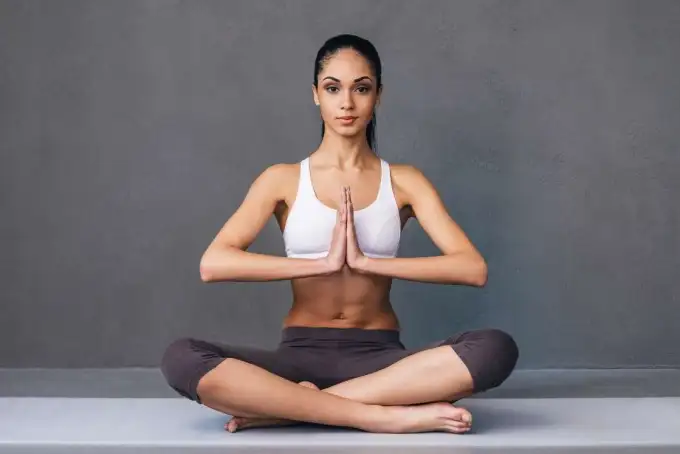
One of the simplest mudras you may use anywhere at any time is the Anjali mudra. Simply put your palms together, with your fingers pointing upward and your thumbs positioned near your chest. This mudra can be done in any relaxed sitting or standing position. You can also practice it during a yoga session by following the steps below.
- First, enter the room in a relaxed yoga pose like Sukhasana, tadasana, or Vrkshasana while maintaining a straight, erect back.
- As you do so, touch the palms of your hands together and then your fingers. Close the space between your fingers while maintaining straight, upward-pointing fingers. Make sure to keep your gesture with light pressure, and avoid forcing your palms together to seal the space in the middle.
Your thumbs should touch your breastbone as you bring your hands up toward your chest. - Keep your elbow parallel to the ground and straight.
- Finally, to control the flow of prana within you, close your eyes and breathe in and out via your nostrils.
- For increased concentration, you can also chant OM. OM chanting will facilitate your meditation.
You must focus completely in order for the Anjali Mudra to function at its finest. I can guarantee that you’ll discover mornings to be the ideal time for practicing. Your mind will be at its most relaxed and uncluttered at this time.
Benefits of Anjali Mudra
By balancing the left and right hemispheres of the brain, the Anjali mudra strengthens the central nervous system. On the body and the mind, it produces calming, soothing, and relaxing benefits. Anjali Mudra’s spiritual qualities enable you to connect with your innermost self.
Anjali Mudra practice has advantages for your mind-body balance, such as;
1. Establishes balance between the left and right hemispheres of the brain
The left hemisphere is thought to be the brain’s logic-heavy side, hence some people take pride in having left hemisphere dominance. That is a false sense of fulfillment, though. The ideal state is to have perfect harmony between the two hemispheres, with neither one dominating the other.
According to popular belief, our left hemisphere excels at processing logic, math, facts, sequences, linearity, and language. The right hemisphere is thought to be the source of emotion, intuition, vision, rhythmic awareness, and artistic expression. You can achieve a balance between the two hemispheres and fully use each one’s enormous potential by using the Anjali mudra.
2. Increases Focus and concentration
There is an interruption in the energy flow every time you lose attention or are unable to concentrate. interruption of brain networks and cognitive processes in the case of concentration. Your awareness, focus, and concentration will be much improved by using the Anjali Mudra, particularly when done in front of the forehead.
3. Enhance blood flow and oxygen management
When the Anjali Mudra is performed in front of the chest, it opens up the energy gateway in your chest, which is the Anahata Chakra. Opening up this chakra cleanses the energy flow in this region. As a result, you achieve enhanced cardiovascular and respiratory functions, and thus, enhanced blood flow and oxygen management. Note, that this benefit is specific to when you perform the mudra in front of your chest.
4. Develop a positive personality
The Anjali mudra is a very humble and friendly mudra. If you can take this mudra beyond the practice of systematic hand gestures, and imbibe it into your lifestyle, wonders will happen to you. You will develop an attitude that is considerate and respectful of all other living beings. Naturally in your social setting, you will become an individual loved and revered.
5. Trigger your spiritual awakening
You can access the energy portals that link your material and spiritual existence when you use the Anjali mudra above and above your head. These versions of the Anjali mudra will raise your awareness of the forces and energies operating in the natural world all around you with consistent practice.
Conclusion
The Anjali mudra is a polite manner to greet all friends and family members as well as strangers and elderly people. Every living thing possesses a small amount of divinity, according to traditional Hinduism. Therefore, when we greet someone using the Anjali Mudra, we are bowing to their innate divinity.
This mudra is typically called Namaste, Namaskar, or Pranam in a literal sense. The word “Anjali Mudra” was first used to describe the gesture’s technical uses in the yogic tradition.














